Séismes et métaphores dans La rive est loin de Ying Chen
Keywords:
séismes, métaphores, Ying ChenAbstract
La rive est loin est le 8ème roman d’un cycle entamé en 1998 avec Immobile. Il s’agit d’un récit allégorique «mêlé» et «mêlan ». Suite à un tremblement de terre, qui a transformé la ville en chaos, un couple est coincé sous les décombres de leur maison. Dans ce roman tout tremble ou s’effondre. En effet, le séisme se propage au sein du récit. Fragmenté et éparpillé, ce dernier génère des doutes. Par ailleurs, les clichés ne sont pas épargnés par ces secousses. Plus inattendu, après avoir été dénoncé comme un lieu commun, le Réalisme vole en éclat. Une telle propagation est possible par des jeux de mises en abîme qui transgressent les limites de l’œuvre.
Seism and metaphors in La Rive est loin by Ying Chen
La Rive est loin is the 8th novel of a series, begun in 1998. After an earthquake, a couple is stranded under the rubbles of their home. Everything in the novel either trembles or crumbles. The seism propagates through the story, fragmenting and dispersing the latter until it destabilizes. Even clichés are not safe from the jolts. Most unexpected, Realism is shattered after being denounced as trite.
Sismi e metafore ne La rive est loin di Ying Chen
La rive est loin è l’ottavo romanzo di un ciclo iniziato nel 1998 con Immobile. Dopo un terremoto che ha trasformato la città in caos, una coppia è intrappolata sotto le macerie della propria casa. In questo romanzo tutto trema o crolla. In effetti, il sisma si propaga all’interno della narrazione. Frammentato e disperso, genera dubbi. Nemmeno le immagini sono esenti da dette scosse. Più inattesa, dopo essere stato denunciato come un luogo comune, è la frantumazione del Realismo. Tale propagazione è resa possibile attraverso le mises en abîme e i giochi metaforici che trasgrediscono i limiti dell’opera.
Downloads
References
Amrit, H. (2014): La littérature migrante est-elle soluble dans l’autofiction? @nalyse, pp. 247-275. Tiré de https://uottawa.scholarsportal.info/ojs/index.php/revue-analyses/article/view/1009/856
Amossy, R. & Herschberg Pierrot, A. (1997): Stéréotypes et clichés. Langue - discours - société. Paris: Nathan.
Barthes, R. (1984): Le Bruissement de la langue. Paris: Seuil.
Barthes, R., Bersani, L. & al. (1982): Littérature et réalité. Paris: Seuil.
Becker, C. (1991): Lire le réalisme et le naturalisme. Paris: Dunod.
Doku (2016): Bibliographie de l’ensemble des travaux portant sur les œuvres de Ying Chen. Tiré de http://auteurs.contemporain.info/doku.php/auteurs/ying_chen
Chen, Y. (1995): La charge. Liberté, 37, 5, pp. 59-65. Tiré de http://www.erudit.org/culture/liberte1026896/liberte1036001/32343ac.html?vue=resume
Chen, Y. (1998): Immobile. Paris: Seuil.
Chen, Y. (2002): Le champ dans la mer. Paris: Seuil.
Chen, Y. (2003): Querelle d’un squelette avec son double. Paris: Seuil.
Chen, Y. (2004): Quatre mille marches. Un rêve chinois. Montréal: Boréal.
Chen, Y. (2006): Le mangeur. Paris: Seuil.
Chen, Y. (2008): Un enfant à ma porte. Paris: Seuil.
Chen, Y. (2010): Espèces. Paris: Seuil.
Chen, Y. (2013): La rive est loin. Paris: Seuil.
Conrad, Th. (2007): La lecture et la structure. Une microlecture de Barthes: La lutte de Jacob avec l’ange. Fabula-LhT, 3. Complications de texte: les microlectures. Tiré de http://www.fabula.org/lht/3/conrad.html
CRIST (Centre de recherche interuniversitaire en sociocritique des textes) (2016): Le manifeste. Tiré de http://www.site.sociocritique-crist.org/p/manifeste.html
Decout, M. (2011): Perec: l’abyme de Robbe-Grillet. Le miroir de Stendhal. Poétique, 168, pp. 399-414.
Dällenbach, L. (1977): Le récit spéculaire. Essai sur la mise en abyme. Paris: Seuil.
Duchet, C. et Maurus, P. (2011): Cheminement vagabond. Nouveaux entretiens sur la sociocritique.
Paris: Honoré Champion (Poétiques et Esthétiques XXe-XXIe siècle).
Lyon-Caen, B. (2011): Claude Duchet, un activisme critique. Acta fabula, 12, 9. Tiré de http://www.fabula.org/acta/document6640.php
Mitterand, H. (1994): L’Illusion réaliste. De Balzac à Aragon. Paris: PUF.
Pagès, A. (2008): Émile Zola: genèse du roman familial. Item. Tiré de http://www.item.ens.fr/index.php?id=377178
Paveau, M.-A. (2006): Les Prédiscours. Sens, mémoire, cognition. Paris: Sorbonne nouvelle.
Popovic, P. (2011): La sociocritique. Définition, histoire, concepts, voies d’avenir. Pratiques, 151-152, pp. 7-38. Tiré de http://pratiques.revues.org/1762
Sarraute, N. (1956): L’Ère du soupçon. Paris: Gallimard.
Vacca, P. (2016, juin): La métaphore dans la fabrique du roman. Colloque Le retour du comparant, Université de Rouen. Tiré de https://webtv.univ-rouen.fr/videos/le-retour-du-comparant-06-07-16-matin-partie-2/
Zola, É. (1960-1967): Les Rougon-Macquart. Histoire naturelle et sociale d’une famille sous le Second Empire (Tomes I-V). Paris: Gallimard.
Zola, É. (2002): Les manuscrits et les dessins de Zola: notes préparatoires et dessins des Rougon-Macquart. Les Racines d’une œuvre (II). O. Lumbroso & H. Mitterand (Éds). Paris: Textuel.
Downloads
Published
How to Cite
Issue
Section
License

This work is licensed under a Creative Commons Attribution-NonCommercial-ShareAlike 4.0 International License.
The authors undertake to comply with the following conditions, which are considered accepted at the time of submission of their contributions.
The sending of a text implies that it is unpublished and not submitted to be published elsewhere.
1. If accepted, the author shall confer on the publisher the right to publish and distribute it both in paper form and in the online electronic edition. The published articles will be downloadable and made available in open access.
2. Provided that it correctly indicates that the first publication took place in the journal Oltreoceano. Rivista sulle migrazioni the author has the right to: a) reproduce the article in separate extracts or collected in a volume; b) publish the article on their personal website or teaching site provided that these sites are of a non-commercial nature; c) deposit the article in online archives of a non-commercial nature, linked to the institution they belong to or as part of projects for the non-commercial dissemination and open access of scientific works.
The use of contributions by third parties, for commercial or otherwise unauthorized purposes, is not allowed. The publisher declines all responsibility for the unauthorized use of the material published in the journal.












